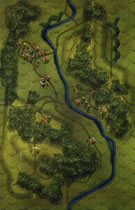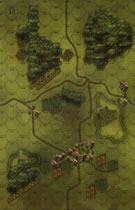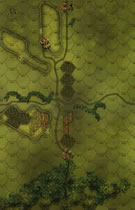|
Grenadiers in Action Polish Exiles #10 |
||
|---|---|---|
| (Attacker) Germany | vs |
France
(Defender)
Poland (Defender) |
| Formations Involved | ||
|---|---|---|
| France |  |
52e Division d'Infanterie |
| Germany |  |
268th Infantry Division |
| Poland |  |
1st Grenadier Division |

|
| Overall Rating, 0 votes |
|---|
|
0
|
| Scenario Rank: --- of 940 |
| Parent Game | Polish Exiles |
|---|---|
| Historicity | Historical |
| Date | 1940-06-16 |
| Start Time | 00:11 |
| Turn Count | 24 |
| Visibility | Day |
| Counters | 100 |
| Net Morale | 0 |
| Net Initiative | 2 |
| Maps | 3: 29, 31, 33 |
| Layout Dimensions | 84 x 43 cm 33 x 17 in |
| Play Bounty | 247 |
| AAR Bounty | 227 |
| Total Plays | 0 |
| Total AARs | 0 |
| Battle Types |
|---|
| Inflict Enemy Casualties |
| Road Control |
| Urban Assault |
| Conditions |
|---|
| Off-board Artillery |
| Terrain Mods |
| Scenario Requirements & Playability | |
|---|---|
| Deluge | Counters |
| Fall of France 2 | Maps + Counters |
| Polish Exiles | Base Game |
| Introduction |
|---|
|
Dieuze, France For two days, the Poles saw very few Germans, and some of their officers questioned whether their French-directed artillery barrages had any target at all, as they drew no counter-battery fire. As they covered the French withdrawal to the Marne-Rhine canal, German motorized units began to overtake and isolate the Polish rearguards. Soon the remaining detachments were fighting and splitting up into less coordinated packs. Many men fell to the Germans as they strayed along the Lorraine roads. On 16 June, the French 45th Corps ordered the 1st Polish Grenadier Division to gain a few hours by holding the Bénestroff-Mittersheim railroad line centered on the small town of Dieuze. The 3rd Battalion of the 2nd Grenadier Regiment would be reinforced by scattered French units. At 1000, the Germans attacked the northern part of Bénestroff. After repelling the first attack for the first time, the Franco-Polish group retreated to the next blocking position, below Bénestroff a few kilometers to the south. On the left flank, the French 291st Infantry Regiment gave way fairly easily and retreated in disorder. On the right, the Germans occupied Bassing before 1100. Before being surrounded, The Poles escaped toward the Bride forest ( to the south-west) under the cover of a French motorcycle squadron and anti-tank units, having suffered nine killed, around 20 wounded and 12 missing). They would make their stand at Dieuze. |
| Conclusion |
|---|
|
The Polish 2nd Grenadier Regiment's II Battalion held Bois de St-Jean to the south of Dieuze, blocking passage between the town and the Lindre ponds to the east. On the German side, the II Battalion of the 499th Infantry Regiment reached Dieuze via the Vergaville road (D22) in the early afternoon, earlier than planned thanks to requisitioned motor vehicles. Together with a French battalion, the Polish artillery shelled the German motorcyclists and then destroyed the trucks loaded with troops approaching the town. The reinforced Germans attacked again around 1500, driving the Polish outposts from the Lindre hills overlooking the ponds. The attack overwhelmed the 88th Chasseurs à Pied Battalion of the 52nd Infantry Division. Its chasseurs withdrew after brief street battles, but lost two isolated companies at Guéblange. Their rout uncovered the Polish left wing, which was only saved by the massive intervention of the Polish artillery group. The Germans resumed their attack at 1700. Preceded by an artillery barrage and supported by an armored car company, it badly mauled the Polish 7th Company, which suffered heavy losses. The situation was less critical on the left flank, where the 5th Company held its ground. Checked for a second time, the Germans continued to harass the Poles until nightfall. The Germans were not concerned with clearing forests and isolated villages; their objective was to seize the main routes, which is why they launched forward motorized detachments with armored cars, motorcyclists, assault guns and light flak, followed by trucks loaded with infantrymen. On June 16, a similar formation attacked the bicycle company of the 348th Infantry Regiment, which was blocking the road to Dieuze. They held out for a few hours before giving in. On the right, the Polish regiment's 3rd Battalion was driven back to Guebling with losses. On the left, despite support from the 75s, the 3rd Battalion of the French 291st Infantry Regiment collapsed and its companies were isolated. One of them retreated across the countryside to cross the canal, while another barricaded itself in Dieuze. Isolated infantrymen and chasseurs took refuge in houses as well. From Hill 254, south of the town, French and Polish artillerymen had a superb observatory. They demolished trucks on the road from Bergaville to Dieuze. At the entrance to the town, elements of the French 75th Infantry Division finally halted the German advance in a street fight. |
| Additional Notes |
|---|
|
Counters from White Eagles may be used instead of those from The Deluge. |
| AFV Rules Pertaining to this Scenario's Order of Battle |
|---|
|
| 2 Errata Items | |
|---|---|

|
The reduced direct fire value of the Heer HMG became 5-5 starting with Fall of France. (plloyd1010
on 2015 Jul 31)
|

|
The SK 7/2 appearing in 1940: Fall of France is actually a SK 6/2, but misprinted by APL. Hence it should be unarmored in that game. The SK 7/2, which appears in other games is correctly printed with an armor of 0. (plloyd1010
on 2022 Apr 28)
|

 PoEx009
PoEx009 





































